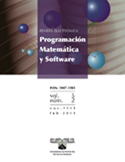Firmador y autenticador de documentos digitales
DOI:
https://doi.org/10.30973/progmat/2014.6.1/4Palabras clave:
protocolos de seguridad, esteganografía, criptografía, huella digital y marcas de aguaResumen
Garantizar que un documento sea auténtico no es una tarea fácil y menos si éste es digital. Actualmente existen muchas herramientas computacionales que permiten falsificar documentos. El objetivo de la investigación descrita en este artículo consistió en desarrollar un servicio web que permitiera incluir mecanismos de seguridad a documentos digitales y con eso garantizar su autenticidad. Para proteger este sitio, se dividieron los procesos en nivel host y nivel network. El primero tiene que ver con los procesos internos tanto del cliente como del servidor, lo cual involucra aspectos de seguridad computacional como esteganografía y criptografía. El segundo nivel tiene que ver con la protección del flujo de información que viaja del cliente al servidor, para ello se desarrolló un protocolo de seguridad basado en criptografía simétrica, que se ha verificado formalmente para tener la seguridad de que matemáticamente se parte de un protocolo seguro. Este artículo reporta los fundamentos técnicos para implementar una aplicación web que permita firmar y autenticar documentos digitales, y a esta aplicación se le ha denominado FADD.
Citas
Kostopoulos, I., Gilani, S. A. M. Skodras, A. N. (2002). Colour image authentication based on a self-embedding technique. DSP 2002, 14th International Conferenceon Digital Signal Processing, 2 (1): 733-736. https://doi.org/10.1109/ICDSP.2002.1028195
Potdar, V. M., Chang Song Han, E. (2005). Survey of digital image water-marking techniques. 3rd International Conference on Industrial Informatics (INDIN 2005), 709-716. https://doi.org/10.1109/INDIN.2005.1560462
Documento del Comité de Agricultura de las Naciones Unidas. Disponible en: ftp://ftp.fao.org/docrep/FAO/Meeting/011/j9289e.pdf
Indicadores Biodiversidad y Bosques. World watch Institute. Disponible en: url: http://www.ecoestrategia.com/articulos/indicadores/indicadores.html#07
López-Pimentel, J. C., Monroy, R. (2008). Formal support to security protocol development: a survey. Journal Computación y Sistemas, special volume 50 Years of Computing in Mexico, 12: 89-108.
Frattolillo. F. (2007). Watermarking protocol for web context. IEEE Transactions on Information Forensics and Security, 2 (3-1): 350-363. https://doi.org/10.1109/TIFS.2007.903849
Frattolillo, F., D’Onofrio, S. (2005). A web oriented watermarking protocol. En: IEC (Praga), 91-96.
Chin-Laung Lei, Pei-Ling Yu, Pan-Lung Tsai, Ming-Hwa Chan (2004). An efficient and anonymous buyer-seller watermarking protocol. ImageProcessing. IEEE Transactions, 13: 1618-1626. https://doi.org/10.1109/TIP.2004.837553
Yusuk Lim, ChangshengXu, Dagan Feng, D. (2001). Web based image authentication using invisible fragile watermark. En: Proceedings of the Pan-Sydney Area Workshop on Visual Information Processing. Volume 11, VIP ‘01: 31-34, Darlinghurst, Australia. Computer Society, Inc.
Lintian Qiao, Nahrstedt, K. (1998). Watermarking schemes and protocols for protecting rightful ownership and customer’s rights. J. Vis. Commun. Image Representation, 9: 194-210. https://doi.org/10.1006/jvci.1998.0391
Memon, N., Wong, P. W. (2001). A buyer-seller watermarking protocol. IEEE Trans. Image Processing, 10: 643-649. https://doi.org/10.1109/83.913598
Diffie, W., Hellman, M. (1976). New directions in cryptography. IEEE Transactions on Information Theory, IT-22 (6): 644-654. https://doi.org/10.1145/3549993.3550007
Donovan Artz. (2001). Digital steganography: Hiding data within data. IEEE Internet Computing, 5: 75-80. https://doi.org/10.1109/4236.935180
Kessler, G. C., Ciphers, N. (2004). An overview of steganography for the computer forensics examiner. Federal Bureau of Investigations, viewed 28.
Potdar, V. M., Han, S., Chang, E. (2005). A survey of digital image watermarking techniques. INDIN ‘05. 3rd IEEE International Conference on Industrial Informatics, 1 (1): 709-716. https://doi.org/10.1109/INDIN.2005.1560462
Lawrence C. Paulson, L. C. (1998). The inductive approach to verifying cryptographic protocols. Journal in Computer Security, 6 (1-2): 85, 128. https://doi.org/10.3233/JCS-1998-61-205
López-Pimentel, J. C., Monroy, R., Ramos-FonBon, V. F. (2011). Symmetric cryptography protocol for signing and authenticating digital documents. En: The ICDIPC2011 proceedings, Communications in Computer and Information Science, Springer LNCS, 9-23. https://doi.org/10.1007/978-3-642-22389-1_2
Lowe, G. (1995). An attack on the need-ham-schroeder public-key authentication protocol. InformationProcessingLetters, 56 (3): 131-133.
Lowe, G. (1997). A hierarchy of authentication specifications. En: Proceedings of the 10th IEEE Computer Security Foundations Workshop, CSFW’97, 31-44. IEEE Computer Society. https://doi.org/10.1109/CSFW.1997.596782
Descargas
Publicado
Cómo citar
Número
Sección
Licencia
Derechos de autor 2014 Programación Matemática y Software

Esta obra está bajo una licencia internacional Creative Commons Atribución 4.0.
Usted es libre de:
 |
Compartir — compartir y redistribuir el material publicado en cualquier medio o formato. |
 |
Adaptar — combinar, transformar y construir sobre el material para cualquier propósito, incluso comercialmente. |
Bajo las siguientes condiciones:
 |
Atribución — Debe otorgar el crédito correspondiente, proporcionar un enlace a la licencia e indicar si se realizaron cambios. Puede hacerlo de cualquier manera razonable, pero de ninguna manera que sugiera que el licenciador lo respalda a usted o a su uso. |
| Sin restricciones adicionales: no puede aplicar términos legales o medidas tecnológicas que restrinjan legalmente a otros a hacer cualquier cosa que permita la licencia. |










